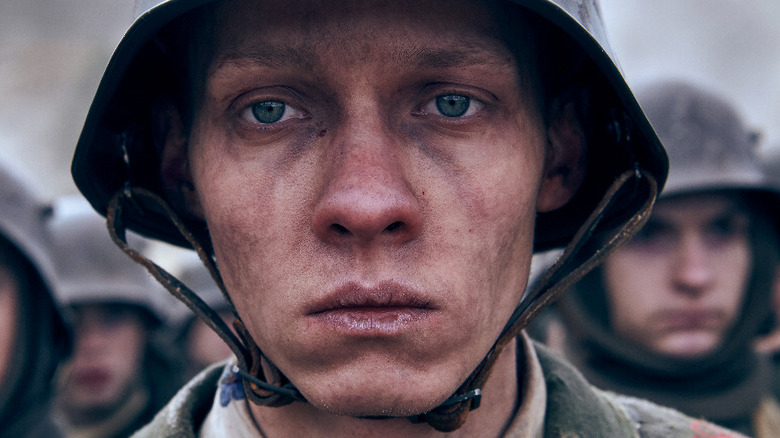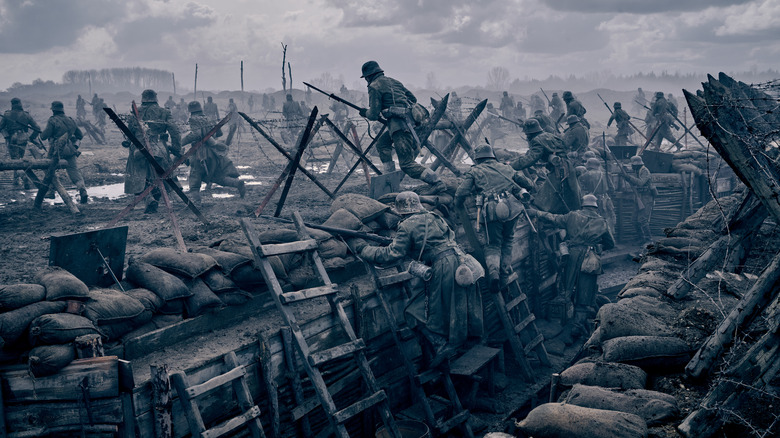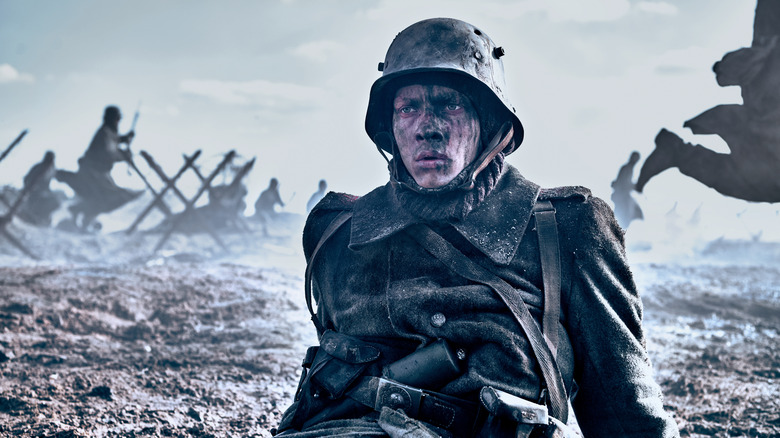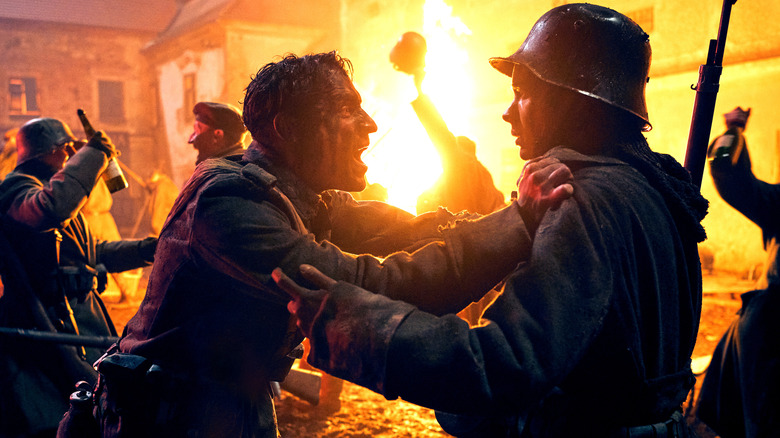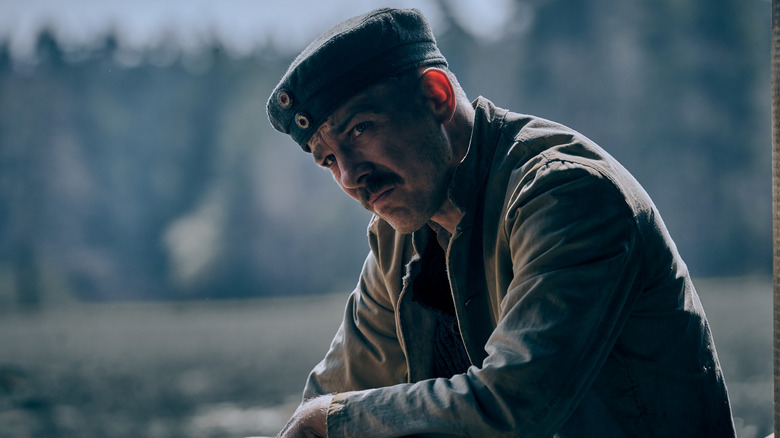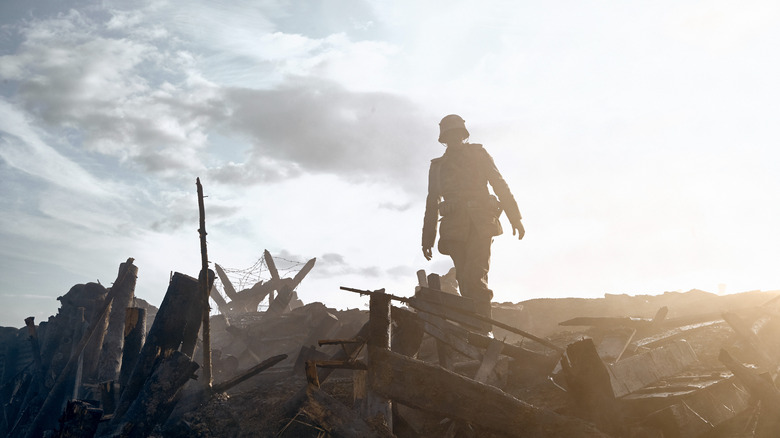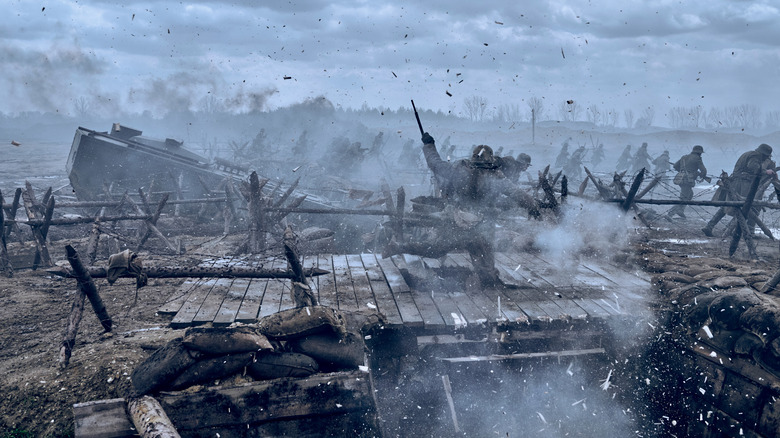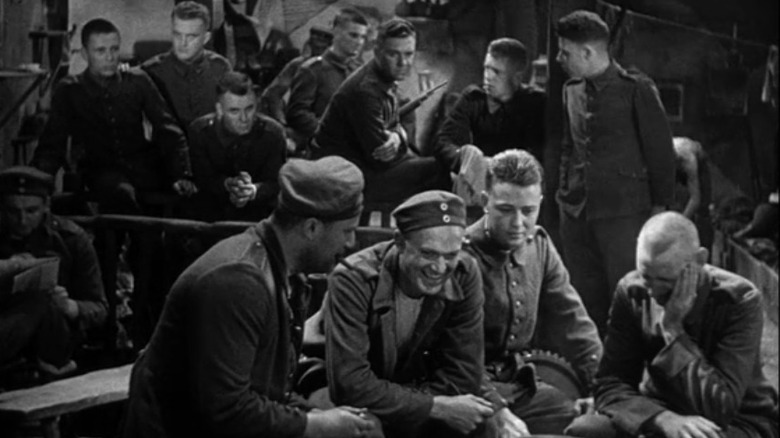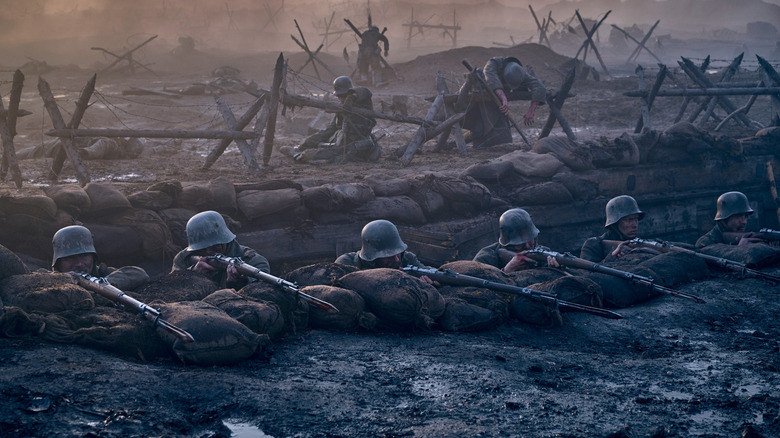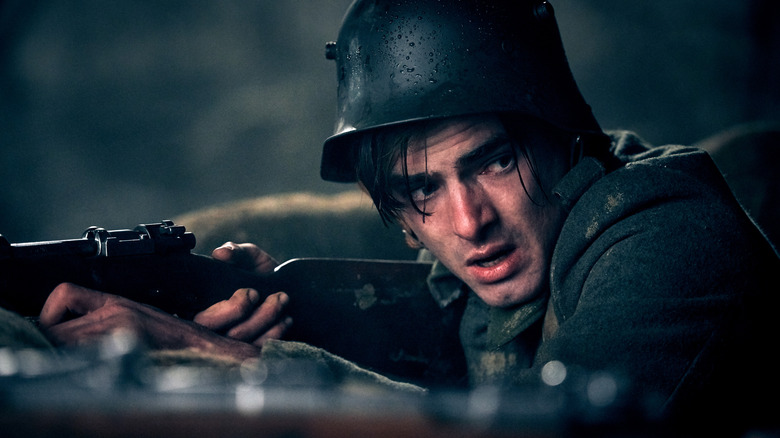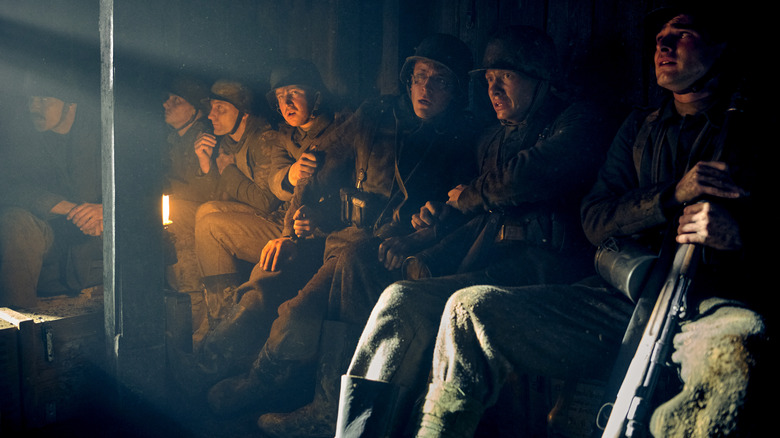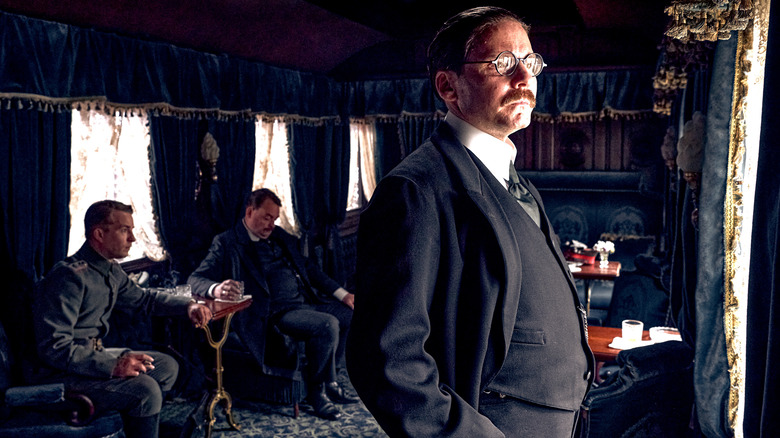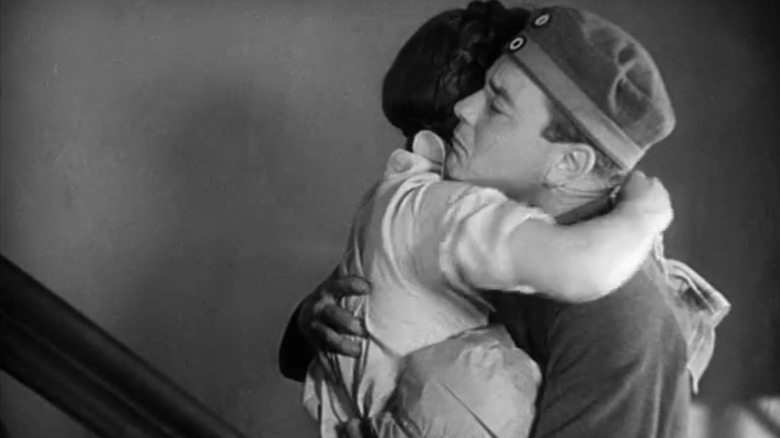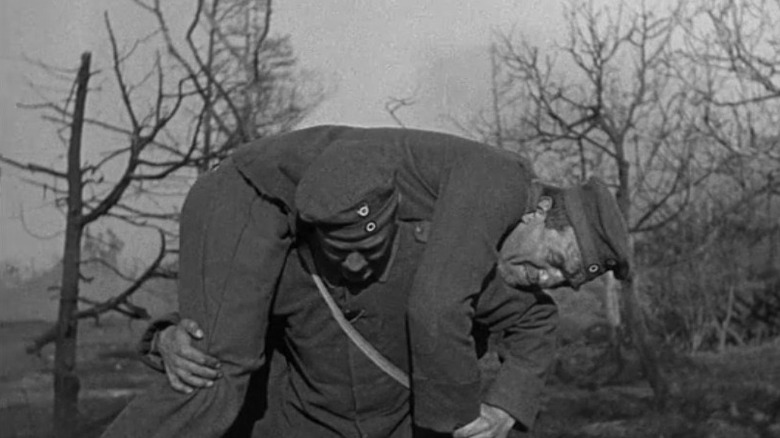Netflix's All Quiet On The Western Front: The Biggest Differences Between The 1930 Version
Contains spoilers for "All Quiet on the Western Front."
Erich Maria Remarque's anti-war novel "All Quiet on the Western Front" is not only a classic of literature but has been adapted into classic films as well. Perhaps the most notable was director Lewis Milestone's 1930 film, which was so effective in depicting the plight of soldiers sent off to war — expecting glory only to discover pain, death, and hopelessness — that it won the Academy Award for Best Picture and its influence can be seen in more recent war movies.
In 2022, director Edward Berger brought a new adaptation to the screen starring Felix Kammerer as Paul, the young German soldier who loses everything, including his humanity, while fighting in the trenches of World War I, and Daniel Brühl (Zemo from the MCU) as Matthias Erzberger, a German officer trying to negotiate an end to the fighting. While both films tell essentially the same story, there are a few key differences that are worth exploring.
Our primary focus will be on how each film chooses to communicate the horrors of war and dehumanization both on the filmmaking side and on a purely narrative level. This is in no way meant to be a critique of either film, merely an examination of how two different filmmakers living during very different times adapt the same material.
The 2002 version starts with action
The original "All Quiet on the Western Front" begins with a mission statement assuring the audience that the film isn't taking sides, but simply recounting events as realistically as possible. It then moves into the patriotic fervor gripping Germany as thousands of the country's young men are being shipped off to France to seek victory for the "Fatherland." It makes the idea of fighting and dying for your country sound like the single greatest duty a man can serve. This, of course, is juxtaposed with the realities of war later on.
Like Steven Spielberg's "Saving Private Ryan," the 2022 version of "All Quiet on the Western Front" starts with fast, intense, and horrifying violence. We see the miserable conditions the soldiers are living in, along with the mass casualties being gunned down and left in the mud. Instead of building to the revelation that war isn't the heroic adventure that propagandists would have you believe it is, the film shows you the despair and inhumanity up front. We then see one soldier getting killed and his uniform being repurposed for our main character, who is none the wiser.
A relentless sense of dread
Not only does 2022's "All Quiet on the Western Front" begin with explosive, bloody violence, the tone never lets up. We go from that startling opening to a few scenes of Paul and his friends feeling so inspired to join the effort that they're practically vibrating with excitement while signing up. However, the film constantly reminds us with visual callbacks to the opening that they are basically signing their lives away.
Once they ship out, the fighting starts and almost never stops. We get a few scenes of quiet reflection here and there, but even those scenes dwell on the inevitable fate awaiting everyone involved. At no point do you ever expect that they will find anything other than terror and despair. This is in stark contrast with the 1930 film, which seems to go out of its way to alleviate the overwhelming horror with moments of lightness and even goofball comedy.
Perhaps the overall tone is the biggest difference between the films: they are both bleak, but the latter dwells in that bleakness while the original offers hope — just to snatch it away.
Germans speaking German
If there's one glaring misstep in the original "All Quiet on the Western Front" (depending on your point of view), it's the fact that all of the German soldiers sound like American stage and film actors from the 1930s. There's no attempt whatsoever to go for any kind of historical accuracy by making them speak the language of their country, nor do they even put on bad German accents. The film might as well have been about Americans entering World War I rather than German soldiers.
That's rectified in the 2022 film, as all the characters speak the language of the country they come from. That means the German soldiers speak German and the French soldiers speak French. It adds a level of authenticity to the film that the original simply doesn't have. It was also one of the draws for producer and actor Daniel Brühl, who recently stated in an interview at the Zurich Film Festival that the prospect of telling such a well-known and respected German story in German really appealed to him, since it had never been done in the nearly 100 years since the book was first published.
The dialogue is stripped down
Aside from the fact that the majority of the dialogue is in German, the 2022 adaptation of "All Quiet on the Western Front" keeps its talk to a minimum. In the 1930 film, characters are almost constantly revealing every thought and feeling in highly stylized monologues about the nature of war, what they expect to find when the war is won, and the pain and fear coursing through them at any given moment.
This could be a tactic used to make full use of moving images with sound ("The Jazz Singer," Hollywood's first talkie, had only been released three years prior), or simply a way of conveying the depth of character that can usually only come across in a novel. In Berger's film, the only people making big speeches are corrupt generals or characters who know nothing of war trying to do their part by motivating young men to ship out and die.
What dialogue we do get is usually the kind of military shouting and screaming we always get in these kinds of movies, or short conversations where more is said with facial expressions than with words.
The gore of war
Just because Lewis Milestone's version of "All Quiet on the Western Front" came out in 1930, that doesn't mean it shies away from the brutality of war. One of the first battle scenes depicted in the film sees a soldier gripping a wire fence when a bomb goes off. In a quick shot, we see that the only thing left of the soldier is his hands and forearms still holding onto the fence. Nothing else in the movie is quite that extreme, but there are plenty of bodies flying all over the place.
As effective as that imagery is, the use of color in the 2022 film brings a shocking realism to the carnage that is difficult to achieve in black and white. There is so much gore in the movie that it puts the most violent horror movies to shame. Some of it comes across as a literal depiction of what soldiers on the front would have seen, while other times it feels more symbolic. For instance, there are shots in a hospital that show that the floor is flooded with blood, bringing to mind a butcher shop rather than a place for healing. The message is clear: in war, human flesh is just meat, plain and simple.
Human lives are disposable
The idea that soldiers are disposable in war is explored in the subtext of the 1930 film, while the 2022 adaptation makes this stunningly overt. Of course, we see how rapidly and violently soldiers are disposed of in the original version, but beyond that, the motif of expendability is handled with a subtler hand. As an example, the character of Mueller (played by Russell Gleason) has a comfortable pair of boots that his friends are jealous of. As he lies in the hospital, clinging to life, one of them asks to have his boots since he won't be needing them.
Later on, in another hospital, they learn of the dying room next to the morgue. Soldiers are wheeled out, but they never come back. All of these hint at the message that the men are sent there solely to die. With Berger's film, we see piles of bodies treated like debris or trash. Name tags are removed from the corpses of soldiers, recorded, and thrown off to the side. Then, of course, there is the recycling of uniforms. As far as the military is concerned, these soldiers are not human, but renewable cannon fodder.
The new film has less camaraderie
While watching the 2022 "All Quiet on the Western Front," it's easy to view everything from Paul's perspective, since the film is primarily concerned with documenting his journey from idealistic patriot to lifeless victim of the war. The original film is also Paul's story, but there is a greater emphasis paid to the men he serves with and the connection they form.
The Lewis Milestone film breaks up the violence with scenes of the men getting to know each other, joking together, and just trying to survive. It's an element of the story that poses the argument that the only thing that keeps you alive in times of war is the people serving with you. That camaraderie keeps them all from ending their own lives or turning into mindless killing machines.
Edward Berger chooses to sideline all of that and focus on the misery instead. The Paul of the original film openly mourns the death of every single one of his comrades, while the latter film shrugs off their deaths and keeps barreling towards the ending of the film, making for an utterly nihilistic viewing experience.
An industrial music score
Film scores weren't that common in the early days of sound cinema, therefore "All Quiet on the Western Front" doesn't have much music other than what's used diegetically, like singing or someone playing music onscreen. Unless, that is, you're watching the silent version, which (according to IMDb) did have an accompanying film score composed by Sam Perry and Heinz Roemheld.
The 2022 film has a surprising lack of score as well, favoring the uncomfortable silences and the screams of men and artillery. But it does feature original music composed by Volker Bertelmann ("The Old Guard") that comes in every so often. It isn't a sweeping score like something produced by John Williams, nor is it the marching, militarized drumming or whistling usually associated with war movies (like "The Bridge on the River Kwai"). It's a blunt, cruel, industrial synth sound. If anything, it's really a recurring motif used to emphasize the constant, grinding defeat of the human spirit. It doesn't take you away or inspire you; instead, it conjures feelings of desolation and soul-crushing repetition.
The horror of mustard gas
World War I saw the introduction of terrifying instruments of war that left a lasting impact on everyone, regardless of whether or not they survived. There are certain images associated with that war that spring to mind whenever it's mentioned, including one of a soldier wearing a gas mask. These were used to keep the soldiers alive when the enemy deployed the deadly use of mustard gas.
Surprisingly, there aren't many gas masks featured in the 1930 adaptation of "All Quiet on the Western Front," which is an odd omission given the rest of the film's unblinking depictions of battle. The 2022 film doesn't include them as much as you might think, but gas masks are employed and we do see the effects of what mustard gas can do. There is a scene where the German soldiers reach a facility stuffed with dead bodies. One of them points out that the soldiers removed their masks too early and the gas wiped them out. While it doesn't factor heavily into the plot, it's an important part of that bloody conflict, and omitting it from a story set during that time feels strange and off somehow.
Here come the tanks
Another terrifying aspect of World War I that only gets a mention in the 1930 "All Quiet on the Western Front" is the introduction of armored tanks as practically unstoppable killing machines. In the 2022 film, we experience the existential horror of facing down one of those vehicles and it leaves everyone shaken.
Prior to their arrival in the film, the battles consist of men tucked away in trenches, firing at other men in trenches. Every so often, those men emerge from the muck and charge on their enemy, resulting in rows and rows of soldiers getting cut down in a torrent of bullets or exploding after stepping too close to a bomb. All that changes when these gun-toting tanks arrive.
They shake the very ground itself as they roll forward, unaffected by the bullets shot at them. They don't stop at the trenches either. Instead, they drive straight into them, crushing soldiers beneath them. It's akin to something you might see in a "Godzilla" film when the king of the monsters saunters his way through Tokyo, leaving the civilians devastated. There's nothing like that in the 1930 film.
A tale of two fronts
The few times that Edward Berger's adaptation of "All Quiet on the Western Front" breaks away from Paul's perspective to tell a wider story is to show what's going on with the officials trying to negotiate an end to the war. The closer Paul gets to completely losing his humanity, the closer these men get to ending the war and saving thousands of lives. It gives the impression that there are two very different kinds of battles being fought on the front.
This also provides the closest thing the film has to a villain (other than war itself), in the form of battle-hungry German General Friedrichs (Devid Striesow). He laments ending the war with diplomacy, preferring to win it with the German army standing victorious on a mountain of dead enemy bodies. Nothing like that exists in the 1930 film. The focus of that film is solely on the experiences of the infantry soldiers putting their lives on the line and suffering for their country. In both films, the crux of everything is what the soldiers see and do, but in the 2022 film, they elaborate on that experience by providing a little more context.
You can't go home again
Toward the end of Lewis Milestone's 1930 adaptation of "All Quiet on the Western Front," Paul takes leave and goes back home for a little rest and relaxation. His sister is thrilled to see him, but Paul has trouble accepting her affection. Their mother is unwell, but she is so happy to have her son home. Seeing her breaks Paul's heart and he isn't sure what to do with himself.
He then goes to visit the school teacher who inspired him to enlist in the first place. The teacher is giving his usual speech about how important and honorable it is to serve in the German army when Paul walks in. He hopes Paul will regale his students with tales of his epic adventures on the front, but Paul breaks down instead. He empties his heart to them, detailing how terrible and scary it is out there, inspiring ridicule from everyone in the room who label him a coward.
Eventually, he realizes he no longer knows how to function as a citizen. The war had taken his humanity from him, so he heads back to the front line early. This does not happen in the 2022 film. Instead, we're shown a scene where Paul thinks he's going home, only to find out he will have to serve in one last attack, and any sense of life he once had drains from him at that moment.
The deaths of Paul and Kat
The one friendship that lasts through the entirety of the 2022 adaptation of "All Quiet on the Western Front" is that of Paul and Kat, aka Stanislaus Katczinsky. This is the same relationship that makes it to the end of the 1930 film as well, but the ultimate fates of these characters are very different in both films. In the later adaptation, Kat is murdered by the son of a farmer whom he and Paul stole from. Paul, on the other hand, is stabbed in the back by an enemy soldier and left to bleed out.
In the 1930 film, Kat is killed by debris from a bomb. It is quiet, unexpected, and heartbreaking. Paul goes back to the trenches where he sees a butterfly just out of reach. Captured by this creature of beauty in the middle of all the hate and chaos, Paul reaches out to rescue the insect. All we see is his hand reaching outside of the trench, before we hear a gunshot and the hand goes limp. It is the last image we see before the film fades to black.
